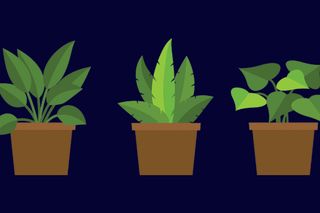
Coming Soon to Your Home: Plants That Can Warn of Environmental Hazards
Can a houseplant be more than just a pretty face?

It is no secret that the air inside and outside our homes is heavily polluted, and that breathing it carries the potential for serious health problems. The good news is an all-natural warning system, which could alert us when air gets particularly hazardous, might be here soon. Researchers from the University of Texas are working to genetically engineer houseplants that would be not only be aesthetically pleasing air filters, but also capable of signally when an environment is unhealthy.
In effect, plants would be turned into biosensors, alerting people to viruses, hazardous gases, mold, and other toxic substances in homes, schools, hospitals and offices, by changing appearance.
“Houseplants are ubiquitous in our home environments,” says study author Neal Stewart, a professor of plant sciences in the UT Herbert College of Agriculture. “Through the tools of synthetic biology it’s possible for us to engineer houseplants that can serve as architectural design elements that are both pleasing to our senses and that function as early sensors of environmental agents that could harm our health….”
Genetically modifying plants is not a new endeavor; the world has been doing it to crops and plants for centuries via selective breeding and, more recently, in the lab. In fact, biosensing crops that can react to certain conditions, like the presence of too much or too little nitrogen, by appearing to ‘glow’ when viewed through specially designed filters, have already been developed. While that work is intended to help farmers, it can also be applied to make houseplants effective monitors of home health, Stewart and co-authors argue in a prospective published in Science magazine.
The authors suggest radiator plants (Peperomia fraseri), spider plants (Chlorophytum comosum), nerve plants (Fittonia albivenis), and peace lilies (Spathiphyllum species) as the most promising houseplants for biosensor adaptation; changes to the hue of their light-colored blossoms and patterned leaves would be easy for people to spot.
To be effective biosensors, however, a number of plants would needed; Rana Abudayyeh, an assistant professor at UT College of Architecture and Design’s School of Interior Architecture, who co-authored the prospective, suggests plant walls would provide the volume of plants needed for biosensing and be aesthetically pleasing.
It’s a new, literal take on the idea of ‘green’ buildings, and it can’t come fast enough for Indian metros. Most of us can’t pick up and permanently move to greener climes to escape air pollution. But with a biosensing plant collection, families might be able to know when take a holiday to avoid the worst air.
“We envisage the next generation of green companions to usher in new interior design paradigms for better health, as well as enhancing the ecology of the built environment,” the authors write in Science.
Related


Scientists Spot 1,200 Genetic Twists Linked to Staying in School
